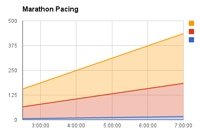Race Strategy
The 6 1/2 Hour Marathon Survivor Race Strategy
Yes, you can finish in the marathon!
The 5 Hour Marathon Runner Race Strategy
The 5 hour goal is a great strategy for new runners who are adequately prepared and experienced athletes.
Run a Faster Marathon
Get that PR, run your best marathon ever.
Marathon Pacing Charts
A handy marathon pacing chart in minutes/mile.
Finish Strong in the Marathon
Don't fade, finish strong
The 4 Hour Marathon Race Strategy
In shape? Go for four!






